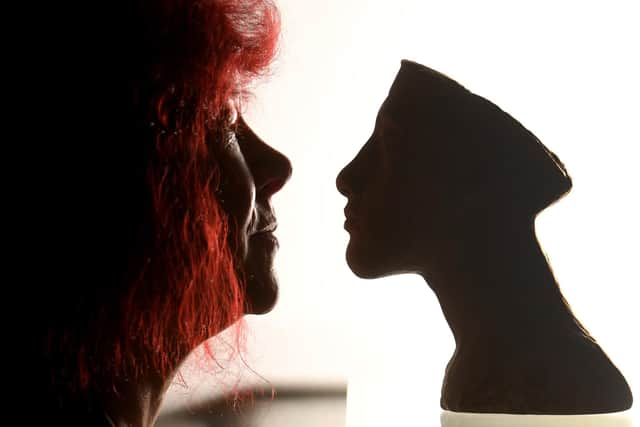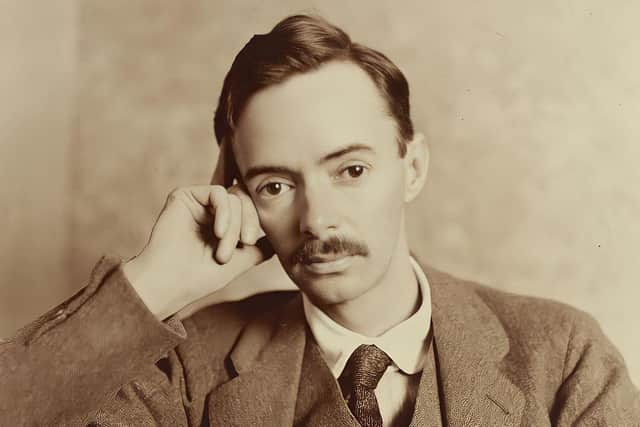TUT'22: Yorkshire Egyptologist's part in Tutankhamun tomb discovery told at Experience Barnsley Museum
Howard Carter's first hand description of opening Tutankhamen's tomb and revealing its breathtaking treasures in Egypt's Valley of Kings is as wondrous today as the jaw-dropping moment when he and Lord Carnarvon made the greatest archaeological discovery of all time 100-years ago.
Now Yorkshire's very own links and key role in the discovery is being told to mark the centenary, writes Graham Walker.
Tut’22: the Life of Tutankhamun, a new exhibition at Experience Barnsley Museum and curated by the town's BAFTA award winning TV Egyptologist Prof Joann Fletcher, is writing local man Harold Jones back into the history books.
Barnsley-born artist-turned-archaeologist Jones uncovered some of the first clues to the location of the tomb and she firmly believes he would have found it first if he had not died tragically young from tuberculosis in the Valley Of The Kings a few years earlier.
Those vital clues helped his friends Carter and Carnarvon to discover the tomb on November 4,1922.
Now, as the world marks the landmark anniversary weekend, the role of Jones and other Barnsley links are celebrated in the Tut'22 exhibition, which runs to March 18.
FREE e-GUIDE: Read the free Tut’22 exhibition guide – with details of special workshops and talks including sessions with curator Prof Joann Fletcher – CLICK HERE.
The exhibition, at the museum inside Barnsley Town Hall, features incredible artefacts and replicas from Tutankhamun’s birthplace Amarna and related sites in Egypt, along with state-of-the-art augmented reality experiences for selfies with 3D pop up images of tomb treasures, including the iconic golden death mask.
Prof Fletcher hopes it will inspire the next generation of Egyptologists to realise their dreams, just as press photos and TV images of the Tutankhamun treasures visiting London in 1972 inspired her as a little girl.
She is now a world renowned Egyptologist and TV presenter, most famous for identifying the mummy of Queen Nefertiti.
Scarborough based Prof Fletcher and her partner Dr Stephen Buckley, an archaeological chemist, were part of the team that won a BAFTA for the 2011 Channel 4 documentary Mummifying Alan: Egypt’s Last Secret, which involved mummifying taxi driver Alan Billis, to replicate rediscovered secrets.
The University Of York duo also helped to successfully recreate the vocal sound of Egyptian mummy Nesyamun, also known as The Leeds Mummy, using a 3D print of his voice box.
In an exclusive interview she told how the new exhibition was three years in the planning but is the culmination of a lifetime's work.
She said: "Growing up in Barnsley in the late 1960s, the story of the discovery combined with colourful pictures of ancient Egyptians in my parents’ history books really sparked something in me before I could even read.
"So when the Tutankhamun exhibition visited the UK in 1972, for the 50 year anniversary, I was so captivated by the images I couldn’t stop talking about it. My Mum told me it was possible to be an Egyptologist as an actual job and that was it – career path chosen by the age of six.


"It also helped that Barnsley library had really great books on the subject and my aunt was a massive Egypt fan too. When she retired we went to Egypt and my mind was blown by everything I saw, including the Tutankhamun treasures.
"I went on to do an Egyptology degree.
"Yet by refusing to ‘lose the accent’ as some advised, I was certainly made aware that I would never be part of ‘the establishment’ and felt very much out of place in a subject which is still far too dominated by the south-east.
"But as I persevered with a PhD, I also began finding all sorts of unexpected connections between Yorkshire and ancient Egypt - amazing people from our county who’d made a massive contribution despite being airbrushed from the history books.
"From York-born scholar George Sandys, who explored Egypt as early as 1611 and wrote the first accurate account of the pyramids in the English language to the first professional female Egyptologist who went to Egypt in the 1830s and came from Scarborough. I even discovered I was not even the first Egyptologist to come from Barnsley. That accolade belongs to the brilliant Harold Jones.
"He was the first to recognise the significance of the then little-known name ‘Tutankhamun'. Not only a friend of Howard Carter, Jones was talent-spotted by Lord and Lady Carnarvon who invited him to stay at their family seat Highclere Castle - the setting of Downtown Abbey.


"Jones died aged only 34, his lifelong struggle with tuberculosis cutting short a career which quite likely could have culminated in finding the tomb of Tutankhamun himself."
Of curating Tut’22 she said: "Suspecting most of the world’s attention would be on the pharaoh’s tomb and death, we decided to focus on Tutankhamun’s life, his birth and childhood in Amarna, some three and a half thousand years ago.
"We needed ancient Egyptian objects from Amarna, some of the finest of which are part of Bolton Museum's world-class collection, which we’ve been studying since 1988. With Bolton very generously allowing us to borrow some of their star items, we even discovered its first curators, father and son William and Thomas Midgley, originally came from a Barnsley family who worked for the Spencer Stanhopes of Barnsley’s Cannon Hall.
"All the links feature on our colourful new displays.
"The exhibition sets the scene by first introducing visitors to Tutankhamun’s family - real superstars of ancient Egypt, including his father Akhenaten and stepmother Nefertiti. There are objects relating to birth and childhood, such as a baby’s feeding bottle and poppy-shaped container for opium, which ancient medical texts recommended to ‘stop the infant crying immediately’.
"Another display focuses on the Nile-side environment of Amarna itself, along with spectacular furnishings which once embellished the city’s royal palaces - ceramic bunches of turquoise grapes hung from the ceilings to create a vineyard-like atmosphere for royal drinking sessions, with golden thrones and well-stuffed cushions set upon tiled and painted flooring. Images of the royal family enjoying the finest food and wines are complemented by some of the food itself, the decorative palace tableware enhancing the vintage wines we know Tutankhamun and his family drank in large quantities.
"We have a linen tunic from the royal wardrobe, a selection of colourful jewellery, cosmetics, perfume vessels and hairstyling equipment all used on a daily basis by Egypt’s most glamorous ancient dynasty.
"Another section covers writing and painting, and with a display of some of the actual paint pigments discovered at Amarna, the archaeologists excavating a room in one of the city’s royal palaces in the 1930s found the floors and lower walls covered in streaks of this same coloured paint, concluding that this must be the playroom of the royal children, Tutankhamun and his six half-sisters.
"Such intimate glimpses into the lives of ancient Egypt’s most famous family have only been made possible by the generosity of Bolton Museum and its multi-talented curator Ian Trumble, plus help and advice from experts including Dr Mohamed Solieman, Marie Woods, Marc Chica and Dr Stephen Buckley.
"Barnsley digital media company Front Row Live have also been working with us for months to make the spectacular gold death mask appear in the exhibition, thanks to the power of augmented reality.
"And with the current Lady Carnarvon, another wonderful supporter, we’ve been able to maintain that magical link between Barnsley Egyptologists and the ongoing story of Tutankhamun."
Tut’22: the life of Tutankhamun runs to March 18, 2023. For more visit www.experience-barnsley.com.
* Resurrecting Ancient Egypt: A Monumental Yorkshire Journey, a Barnsley Museums touring exhibition by Kyte Photography, highlighting Egyptian inspired Yorkshire architecture, also curated by Prof Fletcher, is now open at Scarborough Art Gallery and runs to March 18, 2023. For more visit scarboroughmuseumsandgalleries.org.uk.
MAKE A DONATION: Tut22 is a free entry exhibition but you can make a donation to Barnsley Museums and Heritage Trust which supports the town’s five museums including Experience Barnsley, Cooper Gallery, Cannon Hall Museum, Elsecar Heritage Centre and Worsbrough Mill – find out more and make a donation at www.bmht.org.
